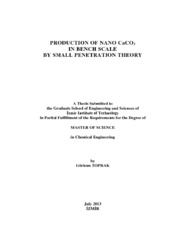Please use this identifier to cite or link to this item:
https://hdl.handle.net/11147/3601Full metadata record
| DC Field | Value | Language |
|---|---|---|
| dc.contributor.advisor | Özdemir, Ekrem | en |
| dc.contributor.author | Toprak, Görkem | - |
| dc.date.accessioned | 2014-07-22T13:51:55Z | - |
| dc.date.available | 2014-07-22T13:51:55Z | - |
| dc.date.issued | 2013 | en |
| dc.identifier.uri | http://hdl.handle.net/11147/3601 | - |
| dc.description | Thesis (Master)--Izmir Institute of Technology, Chemical Engineering, Izmir, 2013 | en |
| dc.description | Includes bibliographical references (leaves: 119-125) | en |
| dc.description | Text in English; Abstract: Turkish and English | en |
| dc.description | xv, 122 leaves | en |
| dc.description | Full text release delayed at author's request until 2015.07.26 | en |
| dc.description.abstract | Calcium carbonate (CaCO3) has been used as filling material in various industries such as paint, paper, and polymeric materials. Using filling materials will enhance some of the physical properties of the composite material and decrease the product costs. Especially, the physical properties of the composite materials were enhanced significantly when the CaCO3 is used in nano sizes. CaCO3 can be produced from natural sources by crushing, grinding, and sieving processes, however, calcite obtained from the natural sources are usually in micron sizes and they are not in the desired quality and purity. Here, it was proposed that the dissolution rate of CO2 is the limiting step in CaCO3 crystallization and a small penetration method was developed for the limited dissolution of CO2 in the Ca(OH)2 solution. When Ca(OH)2 was added into the 10 mM CaCO3, zeta potential values of CaCO3 particles were increased from negative to positive value indicating that CaCO3 particles were stabilized in the presence of Ca(OH)2 solution. Rice-like CaCO3 particles were synthesized at the very early stage of crystallization. When crystallization progresses, the high energetic end sites started to dissolve, and the dissolution was progressed through the inside of the particles resulting in hollow calcite particles. BET surface area of hollow calcite particles was found to be 14.75 m2/g. Different parameters such as Ca(OH)2 flow rate, CO2 flow rate, Ca(OH)2 concentration, pipe diameter etc. were studied. Calcite particles in nano sizes, homogeneous size distribution, hollow shapes, and different morphologies were achieved to be produced. | en |
| dc.language.iso | en | en_US |
| dc.publisher | Izmir Institute of Technology | en |
| dc.rights | info:eu-repo/semantics/openAccess | en_US |
| dc.subject.lcsh | Calcium carbonate | en |
| dc.subject.lcsh | Nanoparticles | en |
| dc.subject.lcsh | Crystallization | en |
| dc.subject.lcsh | Calcium hydroxide | en |
| dc.subject.lcsh | Nanotechnology | en |
| dc.title | Production of nano CaCo3 in bench scale by small penetration theory | en_US |
| dc.type | Master Thesis | en_US |
| dc.institutionauthor | Toprak, Görkem | - |
| dc.department | Thesis (Master)--İzmir Institute of Technology, Chemical Engineering | en_US |
| dc.relation.publicationcategory | Tez | en_US |
| item.grantfulltext | open | - |
| item.openairetype | Master Thesis | - |
| item.fulltext | With Fulltext | - |
| item.cerifentitytype | Publications | - |
| item.openairecristype | http://purl.org/coar/resource_type/c_18cf | - |
| item.languageiso639-1 | en | - |
| Appears in Collections: | Master Degree / Yüksek Lisans Tezleri | |
Files in This Item:
| File | Description | Size | Format | |
|---|---|---|---|---|
| 10010135.pdf | MasterThesis | 16.16 MB | Adobe PDF |  View/Open |
CORE Recommender
Page view(s)
132
checked on Jul 15, 2024
Download(s)
106
checked on Jul 15, 2024
Google ScholarTM
Check
Items in GCRIS Repository are protected by copyright, with all rights reserved, unless otherwise indicated.